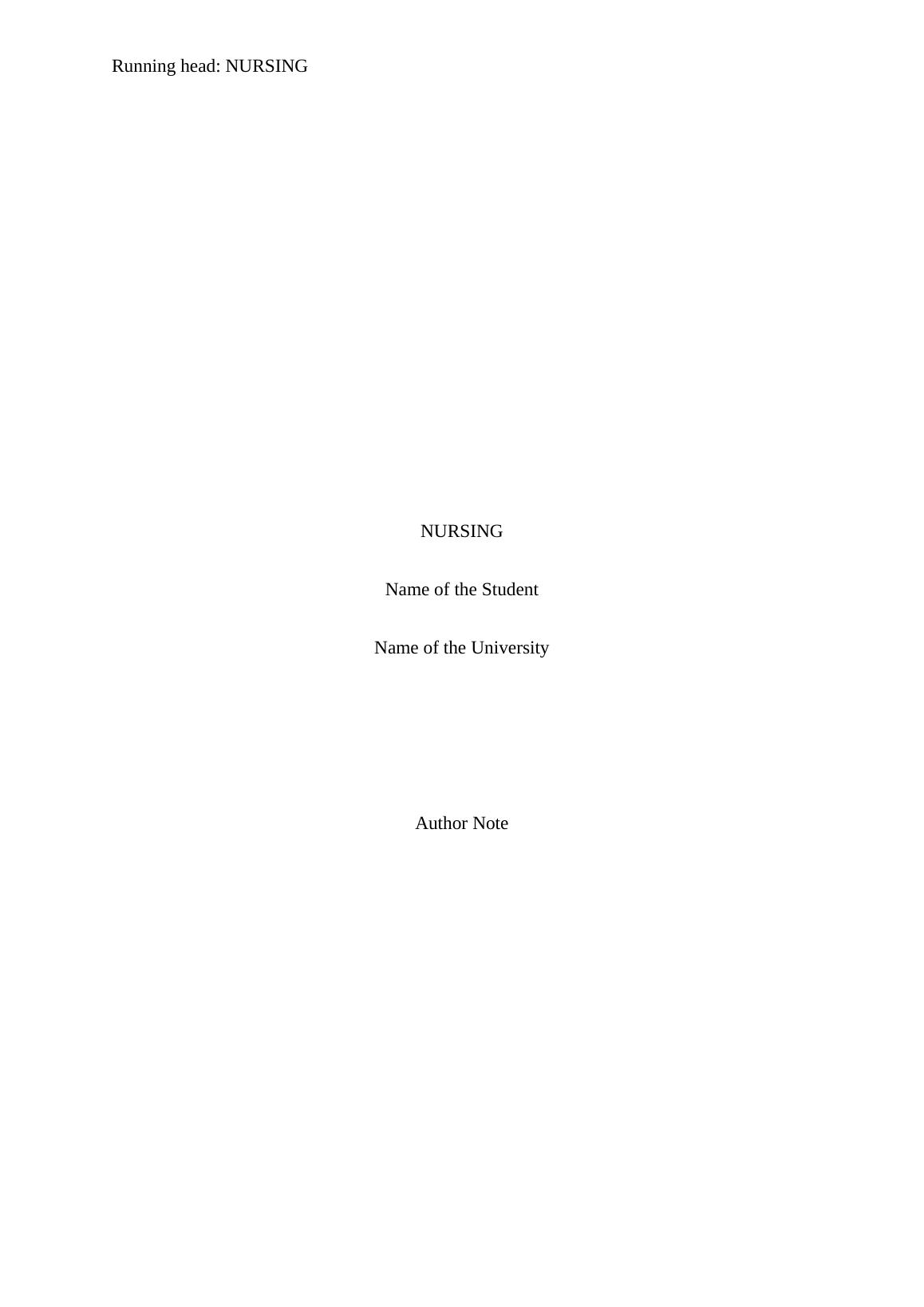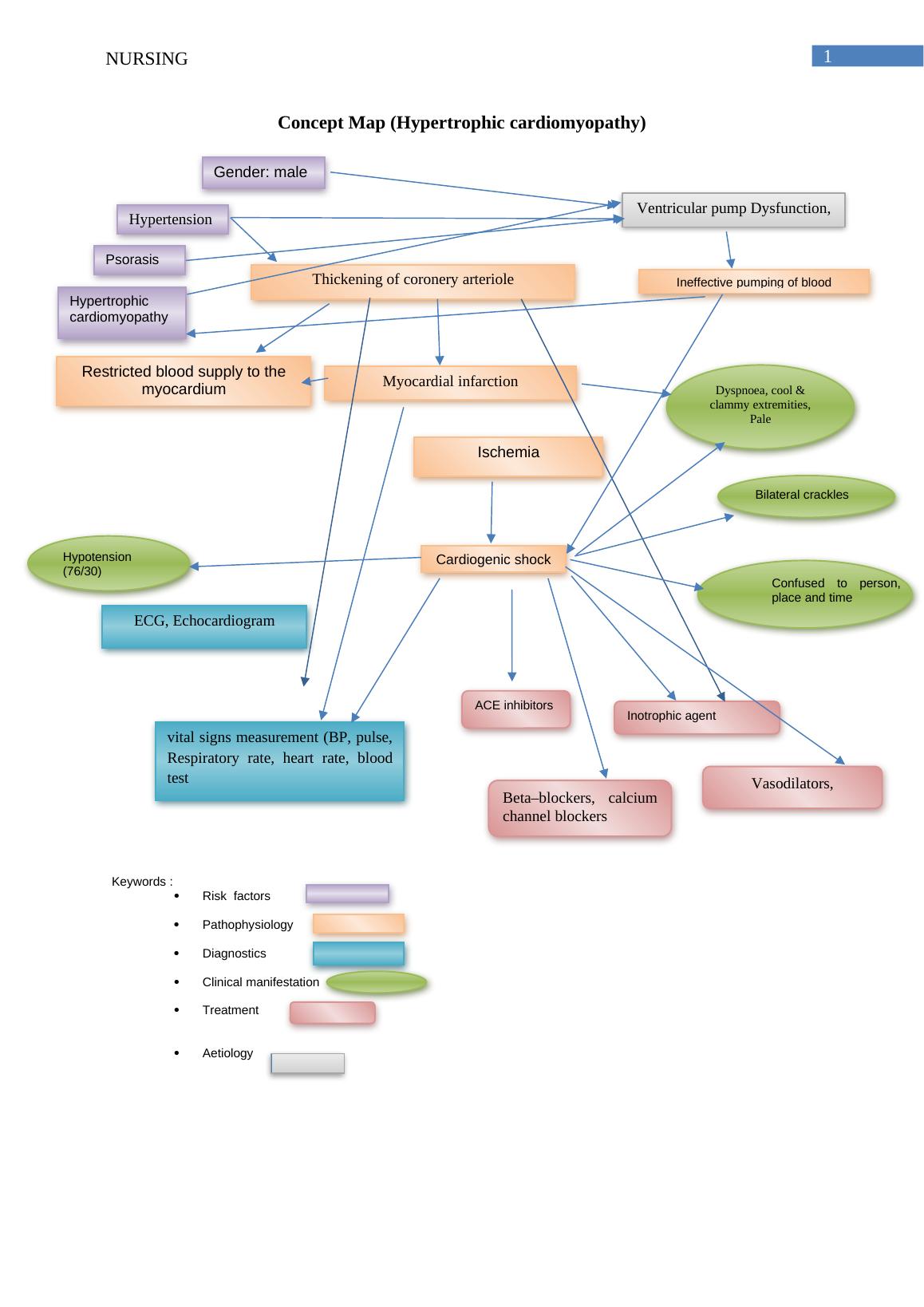Diagnostic Investigations and Treatment Case Study 2022
Added on 2022-10-15
7 Pages1594 Words18 Views
Running head: NURSING
NURSING
Name of the Student
Name of the University
Author Note
NURSING
Name of the Student
Name of the University
Author Note

NURSING
1
Concept Map (Hypertrophic cardiomyopathy)
Keywords :
Risk factors
Pathophysiology
Diagnostics
Clinical manifestation
Treatment
Aetiology
Gender: male
Ventricular pump Dysfunction,
Hypertension
Psorasis
Thickening of coronery arteriole Ineffective pumping of blood
Hypertrophic
cardiomyopathy
Restricted blood supply to the
myocardium Myocardial infarction Dyspnoea, cool &
clammy extremities,
Pale
Ischemia
Bilateral crackles
Hypotension
(76/30) Cardiogenic shock
Confused to person,
place and time
ECG, Echocardiogram
Inotrophic agent
ACE inhibitors
vital signs measurement (BP, pulse,
Respiratory rate, heart rate, blood
test Vasodilators,
Beta–blockers, calcium
channel blockers
1
Concept Map (Hypertrophic cardiomyopathy)
Keywords :
Risk factors
Pathophysiology
Diagnostics
Clinical manifestation
Treatment
Aetiology
Gender: male
Ventricular pump Dysfunction,
Hypertension
Psorasis
Thickening of coronery arteriole Ineffective pumping of blood
Hypertrophic
cardiomyopathy
Restricted blood supply to the
myocardium Myocardial infarction Dyspnoea, cool &
clammy extremities,
Pale
Ischemia
Bilateral crackles
Hypotension
(76/30) Cardiogenic shock
Confused to person,
place and time
ECG, Echocardiogram
Inotrophic agent
ACE inhibitors
vital signs measurement (BP, pulse,
Respiratory rate, heart rate, blood
test Vasodilators,
Beta–blockers, calcium
channel blockers

NURSING
2
Risk factors, Aetiology
The following case study deals with the medical condition of a patient named Erik
Selvig. He had a medical history of hypertension, psoriasis and hypertrophic cardiomyopathy.
He was presented to the emergency department due to worsening dyspnoea as well as cool
clammy extremities. On diagnosis, Blood pressure was recorded to be 124/73 mm/Hg and his
ECG reveals to have experienced anterior ST myocardial infarction. The case study further
adds that after three hours of his arrival in the emergency, his dyspnoea deteriorated along
with crackles bilaterally. His blood pressure also dropped to 70/30mm/Hg, his skin became
pale and cool and suffered from confusion. The physicians diagnosed that Erik had diagnosed
with cardiogenic shock because of ventricular pump dysfunction. Gender can be another risk
factor for ventricular dysfunction in patient. Women has been found to be having a better
cardiac function than men.
Cardiogenic shock is defined as a diseased condition where one individual’s heart
suddenly stops pumping blood (Lim, 2016). Cardiac pump failure is often caused due to
massive heart attack but not in case of all individuals. 80% of individuals having a heart
attack may not lead to a cardiogenic shock. The main risk factors behind the cause of the
ventricular pump dysfunction can be due to damaged heart muscles, caused due to
myocardial contusion. The case study states that there had been a past history of myocardial
infarction in Erick Selving. Another risk factor associated to Erick is psoriasis. Studies have
found that the inflammation associated with psoriasis can increase the risk of the stroke and
heart attack as the inflammation tends to damage the arteries, causing blockage or plaques
inside the blood vessels (Van Herck et al., 2017). Psoriasis has again been associated hyper
cardiomyopathy as recently the inflammation characteristics of cardiomyopathies have been
discovered.
2
Risk factors, Aetiology
The following case study deals with the medical condition of a patient named Erik
Selvig. He had a medical history of hypertension, psoriasis and hypertrophic cardiomyopathy.
He was presented to the emergency department due to worsening dyspnoea as well as cool
clammy extremities. On diagnosis, Blood pressure was recorded to be 124/73 mm/Hg and his
ECG reveals to have experienced anterior ST myocardial infarction. The case study further
adds that after three hours of his arrival in the emergency, his dyspnoea deteriorated along
with crackles bilaterally. His blood pressure also dropped to 70/30mm/Hg, his skin became
pale and cool and suffered from confusion. The physicians diagnosed that Erik had diagnosed
with cardiogenic shock because of ventricular pump dysfunction. Gender can be another risk
factor for ventricular dysfunction in patient. Women has been found to be having a better
cardiac function than men.
Cardiogenic shock is defined as a diseased condition where one individual’s heart
suddenly stops pumping blood (Lim, 2016). Cardiac pump failure is often caused due to
massive heart attack but not in case of all individuals. 80% of individuals having a heart
attack may not lead to a cardiogenic shock. The main risk factors behind the cause of the
ventricular pump dysfunction can be due to damaged heart muscles, caused due to
myocardial contusion. The case study states that there had been a past history of myocardial
infarction in Erick Selving. Another risk factor associated to Erick is psoriasis. Studies have
found that the inflammation associated with psoriasis can increase the risk of the stroke and
heart attack as the inflammation tends to damage the arteries, causing blockage or plaques
inside the blood vessels (Van Herck et al., 2017). Psoriasis has again been associated hyper
cardiomyopathy as recently the inflammation characteristics of cardiomyopathies have been
discovered.

End of preview
Want to access all the pages? Upload your documents or become a member.
Related Documents
Pathophysiology and Pharmacology Case Study 2022lg...
|8
|1379
|11
Human Pathophysiology and Pharmacology | Case Study | PPTlg...
|22
|420
|15
